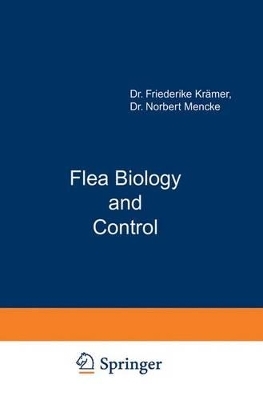
Flea Biology and Control
Springer Berlin
978-3-540-41776-7 (ISBN)
- Titel ist leider vergriffen;
keine Neuauflage - Artikel merken
1 Introduction.- 2 General Morphology.- 3 Taxonomy.- 4 Dissemination and Economic, Veterinary and Medical Importance.- Origin and Distribution.- Economic Importance.- Veterinary Importance.- Medical Importance.- 5 Developmental Cycle of Fleas.- Eggs.- Larvae.- Pupae.- Preemerged Adults.- Adults.- 6 Flea Epidemiology.- 7 Flea-Related Dermatitis.- Flea Bite Dermatitis.- Flea Allergy Dermatitis (FAD).- Clinical Signs.- Differential Diagnosis of FAD.- Histopathological Findings.- Immunopathogenesis of FAD.- Diagnosis of FAD and Flea Bite Dermatitis.- Treatment of Flea-Related Skin Diseases.- Adjunctive Medical Therapy.- Hyposensitization.- Treatment of the Premises.- Indoor Treatment.- Outdoor Treatment.- 8 Resistance.- 9 Imidacloprid.- History of Imidacloprid.- Chemical Properties of Imidacloprid.- Biological Profile, Mode of Action and Direct Insecticidal Activity.- Biological Profile.- Mode of Action and Direct Insecticidal Activity.- Indirect Insecticidal Effects.- Resistance of Sucking Pests Against Imidacloprid.- Toxicology and Pharmacology of Imidacloprid.- Symptomatology of Insects.- Pharmacology of Imidacloprid.- Pharmacokinetics and Metabolism of Imidacloprid.- Toxicology of Imidacloprid.- Toxicology of Imidacloprid 10% Spot-on.- Tolerability of Imidacloprid 10% Spot-on in Dogs and Cats.- Ecological Effects and Ecotoxicological Studies.- Safety Assessment for Humans.- Imidacloprid as a Veterinary Product for Flea Control.- Clinical Efficacy of Imidacloprid (Advantage®) in Dogs and Cats.- Laboratory Studies in Dogs.- Field Studies in Dogs.- Laboratory Studies in Cats.- Field Studies in Cats.- Comparative Studies (Between Imidacloprid and Other Compounds for Flea Control).- Laboratory Studies.- Field Studies.- Larvicidal Effect of Imidacloprid and Efficacy Enhancement (with PBO).- Larvicidal Effect.- Efficacy Enhancement.- Environmental and Habitual Factors Influencing Imidacloprid Treatment.- Effects of Shampooing and Repeated Water Exposure.- ‘Umbrella Effect’.- Small Domestic Animals.- Rabbits.- Ferrets.- Rodents and Other Small Animals.- Ectoparasitic Spectrum of Activity.- Louse Infestation.- Sheep Ked Infestation.- References.
| Erscheint lt. Verlag | 19.6.2001 |
|---|---|
| Zusatzinfo | XIII, 192 p. 8 illus. With CD-ROM. |
| Verlagsort | Berlin |
| Sprache | englisch |
| Maße | 155 x 235 mm |
| Gewicht | 575 g |
| Themenwelt | Medizin / Pharmazie ► Medizinische Fachgebiete ► Mikrobiologie / Infektologie / Reisemedizin |
| Medizin / Pharmazie ► Studium | |
| Naturwissenschaften ► Biologie ► Zoologie | |
| Veterinärmedizin | |
| Schlagworte | Biology • Cat flea • chloronicotinyl • Ctenocephalides felis • Diagnosis • flea biology • imidacloprid • insect • MIC • Morphology • Neonicotinoide • therapy |
| ISBN-10 | 3-540-41776-1 / 3540417761 |
| ISBN-13 | 978-3-540-41776-7 / 9783540417767 |
| Zustand | Neuware |
| Haben Sie eine Frage zum Produkt? |